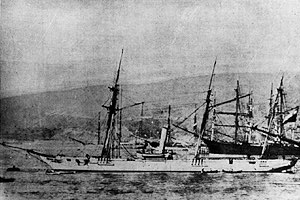
Huáscar is an ironclad turret ship owned by the Chilean Navy built in 1865 for the Peruvian government. It is named after the 16th-century Inca emperor, Huáscar. She was the flagship of the Peruvian Navy and participated in the Battle of Pacocha and the War of the Pacific of 1879–1883. At the Battle of Angamos, Huáscar, captained by renowned Peruvian naval officer Miguel Grau Seminario, was captured by the Chilean fleet and commissioned into the Chilean Navy.

The Battle of Angamos was a naval encounter of the War of the Pacific fought between the navies of Chile and Perú at Punta Angamos, on 8 October 1879. The battle was the culminating point of a naval campaign that lasted about five months in which the Chilean Navy had the sole mission of eliminating its Peruvian counterpart. In the struggle, two armored frigates, led by Commodore Galvarino Riveros Cárdenas and Navy Captain Juan José Latorre battered and later captured the Peruvian monitor Huáscar, under Rear Admiral Miguel Grau Seminario.

Agustín Arturo Prat Chacón was a Chilean lawyer and navy officer. He was killed in the Battle of Iquique, during the War of the Pacific.

The Chincha Islands War, also known as Spanish–South American War, was a series of coastal and naval battles between Spain and its former colonies of Peru, Chile, Ecuador, and Bolivia from 1865 to 1879. The conflict began with Spain's seizure of the guano-rich Chincha Islands in one of a series of attempts by Spain, under Isabella II, to reassert its influence over its former South American colonies. The war saw the use of ironclads, including the Spanish ship Numancia, the first ironclad to circumnavigate the world.

The Battle of Abtao was a naval action fought on February 7, 1866, during the Chincha Islands War, between a Spanish squadron and a combined Peruvian-Chilean fleet, at the island of Abtao in the Gulf of Ancud near Chiloé Archipelago in south-central Chile. It was limited to a long-range exchange of fire between the two squadrons, as the allied ships, anchored behind the island, were protected by shallow waters inaccessible to the Spanish ships, whose gunnery, nevertheless, proved more accurate and inflicted damage to the Chilean and Peruvian ships.

The Naval Battle of Papudo was a naval engagement fought between Spanish and Chilean forces on November 26, 1865, during the Chincha Islands War. It was fought 55 miles north of Valparaiso, Chile, near the coastal town of Papudo.

The Battle of Punta Gruesa was a naval action that took place on May 21, 1879, during the War of the Pacific between Chile and Peru. This may be labelled as the second part of the Naval Battle of Iquique, although it is described in many sources as a separate battle.

Juan Williams Rebolledo was a Chilean rear admiral who was the organizer and commander-in-chief of the Chilean navy in 1879 at the beginning of the War of the Pacific. As a politician, he was elected from Valparaiso to the national Congress in 1867, and in 1873 he was elected as city councillor.

Juan José Latorre Benavente Chilean Vice Admiral, one of the principal actors of the War of the Pacific, and hero of the Battle of Angamos.
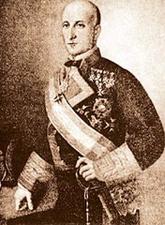
Vice Admiral José Manuel de Pareja y Septien was a Spanish naval officer, who commanded the Spanish forces during the Chincha Islands War (1864-1866).
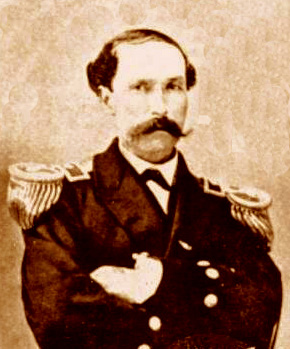
Juan Guillermo Moore Ruiz was a British Peruvian navy officer. He was killed during the Battle of Arica.
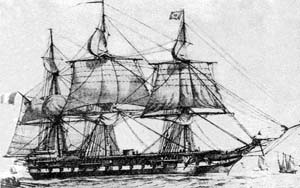
BAP Apurímac was the second steam frigate of the Peruvian Navy, built in England in 1855 along with the steam schooners Loa and Tumbes as a part of a major build-up of the Navy during the government of President José Rufino Echenique. A veteran of two wars and many internal conflicts, due to her age, she served as training ship in Callao port from 1873 until January 17, 1881, when she was scuttled along with the rest of the Peruvian Navy to prevent capture by Chilean troops who had occupied the port after the defeat of the Peruvian Army in the battles of San Juan and Miraflores.

Carlos Arnaldo Condell De La Haza was a Chilean naval officer and hero of the Battle of Punta Gruesa during the start of the War of the Pacific.

The Naval campaign of the War of the Pacific or Saltpeter war, was a naval campaign that took place from 1879 to 1884, involving Peru, and Chile, undertaken in order to support land forces in the Atacama Desert. Although the conflict lasted until 1884, the primary naval engagements occurred between 1879 and 1880. Due to the rough terrain and few transport methods it was imperative to have control of the ports in order to have a good supply source in the region. It resulted in a successful campaign by Chile, and the success of their land campaigns eventually led to a Chilean victory, which cut off Bolivia's access to the coast.
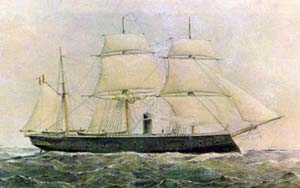
BAP Independencia was a broadside ironclad built in England for the Peruvian Navy during the mid-1860s. During the War of the Pacific of 1879–83, Independencia ran aground while pursuing the Chilean schooner Covadonga during the Battle of Punta Gruesa on 21 May 1879. The survivors were rescued by Huáscar and the wreck destroyed to prevent its capture.

Esmeralda was a wooden-hulled steam corvette of the Chilean Navy, launched in 1855, and sunk by the Huáscar on 21 May 1879 at the Battle of Iquique during the War of the Pacific.

The Battle of Iquique was a naval engagement on 21 May 1879, during the War of the Pacific, where a Chilean corvette commanded by Arturo Prat Chacón faced a Peruvian ironclad under Miguel Grau Seminario. The battle occurred off the port of Iquique, Peru, and ended with the sinking of the Chilean wooden corvette Esmeralda by the Peruvian ironclad Huáscar after four hours of combat, marking a victory for Peru.

The Tarapacá campaign was a short stage of the War of the Pacific in the last months of 1879, after the Chileans won definitive naval superiority at Angamos. It took its name from the region where it was fought.

Juan Bravo was a Chilean Navy sailor of Mapuche origin, hero of the naval Battle of Punta Gruesa during the War of the Pacific. Juan Bravo distinguished himself in the Battle of Punta Gruesa where he, while on board the schooner Covadonga, sniped down numerous Peruvians on board the ironclad Independencia.

The Raids of the Huáscar were a series of raids that occurred by the Peruvian ironclad Huáscar under the command of Miguel Grau Seminario during the War of the Pacific. The actions kept the Chilean government in check for nearly five months which ended after the Battle of Angamos.
